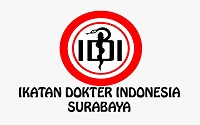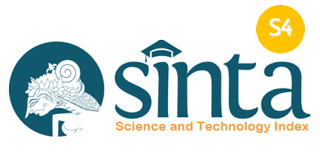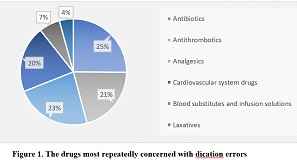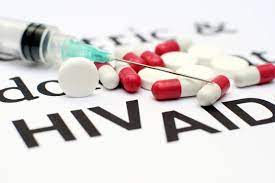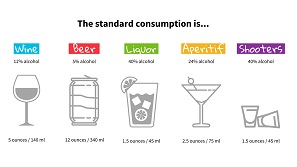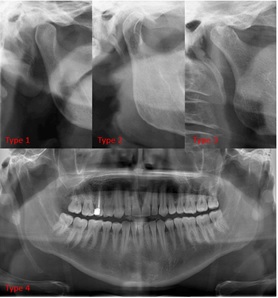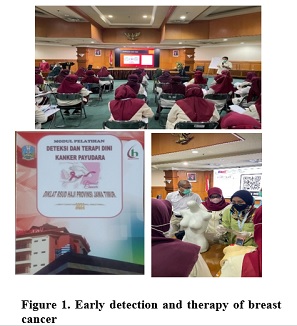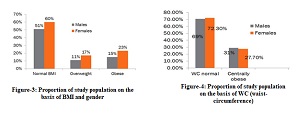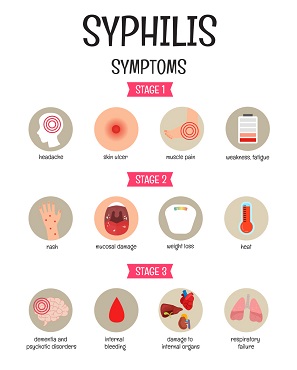Community Knowledge on Child Gastrointestinal Disease, Growth, and Development : A Cross Sectional Study in Mandangin Islan, Sampang, Indonesia

The prevalence of diarrhea in Madura is higher than in East Java. Mandangin island, an isolated island in Sampang, Madura has limited access to healthcare and knowledge. It will lead to disruptions in the children’s growth and development. This study aimed to evaluate the impact of health education on community knowledge about gastrointestinal disorders and children’s development. This cross-sectional study involved 48 subjects from Mandangin Island, Sampang by total sampling. The subjects received some presentations related to gastrointestinal disease, growth, and development in children using a handbook and audio-visual media. The subjects were required to complete pretest and posttest questionnaires. The pretest and post-test results were processed and analyzed using the statistical software “SPSS” and the Wilcoxon test. Most of the subjects were housewives with a mean age of 28.73 ± 6.22 years old. There was a significant difference between pre-and post-test in gastrointestinal disease, growth, and development in children (46.04 ± 21.71 vs 62.29 ± 13.25, p<0.001). This study found that health education through face-to-face, handbooks, and audiovisual media can enhance community knowledge.
INTRODUCTION
Indonesia is a country with the fourth-largest child population in the world. Children are highly susceptible to the health risks of environmental exposures during their crucial developmental phase. Contaminated water, air, food, and soil pose serious threats, leading to digestive issues and hindering proper growth and development. Many children still lack access to adequate nutrition11. A common digestive issue that often occurs is diarrhea. Diarrhea continues to be a prevalent infectious disease in Indonesia, with a prevalence rate in toddlers reaching 12.3% and being the main cause of death in neonates at 7% and in infants aged 28 days at 6%22. It remains a primary cause of both child mortality and morbidity, predominantly attributed to suboptimal water, sanitation, and hygiene practices. Inadequate sanitation and hygiene correlate with elevated rates of stunting and malnutrition in children33. With a prevailing rate exceeding 40% in children, stunting persistently represents a profound health challenge within the community population4,545. This indicates that the child has endured a prolonged period of insufficient dietary intake and/or has been frequently exposed to illness6–8678.
In the Sampang region, one of the regencies in East Java, the diarrhea prevalence (46.3%) was higher than in the whole East Java (44.8%)99. Mandangin Island, an isolated area in Sampang, has limited access to healthcare and education. This is compounded by the low community participation in nutrition improvement efforts with a significant portion of the population having only completed primary education10,111011. The majority of the community holds the belief that monitoring a child's development is unnecessary after completing full immunization. Insufficient exclusive breastfeeding and the utilization of rainwater for daily needs, particularly during the rainy season, increase the risk of cleanliness-related infectious diseases in children, particularly gastrointestinal diseases1212.
Gastrointestinal diseases are predominantly preventable and treatable conditions1313. Community empowerment plays a crucial role in both prevention and initial treatment. Therefore, this study aimed to evaluate community knowledge of gastrointestinal disorders, growth, and development in children.
MATERIALS AND METHODS
This study employed a cross-sectional design. 48 daily active people of Mandangin Island were included in this study utilising the total sampling method. After completing the pretest questionnaire independently, the participants then received a direct health education intervention on gastrointestinal disease, growth, and development in children. A pediatrician and a doctor conducted this face-to-face activity using a presentation medium that the community could easily understand. Following the presentation, a discussion session between participants and speakers ensued. During this discussion, the speakers and other attending pediatricians encouraged participants to pose questions or share experiences related to the presented material. Each participant also received a handbook about gastrointestinal disease, growth, and development in children. We then administered a posttest using the same protocol as the pretest.
This study used pre and post-test questionnaires with 10 questions and demographic data. Statistical tests were used to compare results with normality testing for a limited number of participants (<50) using the Shapiro-Wilk test and Paired T-test for Windows, p > 0.05 was considered normal distribution.; otherwise the Wilcoxon test would be applied. Sociodemographic data were presented using univariate analysis.
In addition to the community health education for the Mandangin Island, medical check-ups were carried out for children under the age of five who voluntarily visited the examination site. These check-ups involved gathering medical history, conducting physical examinations, taking anthropometric measurements, and providing pediatric consultations. History taking covered current patient or family complaints, and demographic data such as age, gender, gestational age, birth weight, and birth length.
Anthropometric measurement included weight, length/height, head and upper arm circumference using standardized tools such as One-Med digital weighing scales and microtones for older children, One-Med baby scales and infantometers for infants, and General Care upper arm and head circumference tapes. Anthropometric data was graphed using WHO z-score 2006 charts for weight-for-age, length/height-for-age, and weight-for-length/height; Nellhaus 1968 chart for head circumference; and Indonesian Ministry of Health classification for upper arm circumference14,151415. Univariate analysis was used to present the characteristics data of children under 5 years on Mandangin Island for each variable. All statistical tests were performed using IBM Statistical Product and Service Solutions (SPSS) Software version 16.0 for Windows.
RESULTS
The study involved forty-eight female subjects who were dominated by housewives with a mean age of 28.73 ± 6.22 years old. The subject characteristics are described in Table 1. After the intervention using a handbook and audio-visual media, there was an increase in the mean posttest score (62.29±13.25) compared to the mean pretest score (46.04±21.71), with a significance value of 0.001 (p<0.05) (Figure 1).
Figure 1.Example caption for this image
Variables | N (n=48) or mean ± SD | Percentage (%) |
| Age | 28.73 ± 6.22 | |
| Occupation | ||
| Housewife | 43 | 89.59 |
| Fisherman | 1 | 2.08 |
| Cadres | 3 | 6.25 |
| Teacher | 1 | 2.08 |
| Sex | ||
| Female | 48 | 100 |
| Male | 0 | 0 |
| Educational | ||
| Level Not School | 13 | 27.09 |
| Elementary School | 25 | 52.08 |
| Junior High School | 10 | 20.83 |
In this study, children under five years old were equally divided between boys and girls, with a mean age of 28±13.14 months. Most of them were born at full-term gestational age. The mean birth weight was 2949±517.67 grams, classified as normal birth weight. The mean height was 49±1.93 cm.
About 47.8% of the children under five years old
Haryanto B. Indonesia: Country report on children’s environmental health. Rev Environ Health. 2020;35(1):41–8. DOI : 10.1515/reveh-2019-0088
Ministry of Health, Republic of Indonesia. Riskendas 2018. Lap Nas Riskesndas [National Basic Health Research Report ( Riskesdas)] 2018 [Internet]. 2018;44(8):181–222. Available from: http://www.yankes. kemkes.go.id/assets/downloads/PMK No. 57 Tahun 2013 tentang PTRM.pdf https://dinkes.babelprov.go.id/sites/default/files/dokumen/bank_data/20181228%20-%20Laporan%20Riskesdas%202018%20Nasional-1.pdf
Kementerian Perencanaan Pembangunan Nasional (Bappenas), United Nations Childrens Fund (UNICEF). Laporan Baseline SDG tentang Anak-Anak di Indonesia [SDG Baseline Report about Children in Indonesia]. BAPPENAS dan UNICEF [Internet]. 2017;1–105. Available from: https://www.unicef.org/indonesia/media/9251/file/Ringkasan Eksekutif Strategi Komunikasi.pdf https://www.unicef.org/indonesia/media/1471/file/SDG%20Baseline%20report%20Indonesian.pdf
Saleh A, Syahrul S, Hadju V, Andriani I, Restika I. Role of Maternal in Preventing Stunting: a Systematic Review. Gac Sanit [Internet]. 2021;35:S576–82. Available from: DOI :10.1016/j.gaceta.2021.10.087
Quamme SH, Iversen PO. Prevalence of child stunting in Sub-Saharan Africa and its risk factors. Clin Nutr Open Sci [Internet]. 2022;42(2022):49–61. Available from: DOI :10.1016/j.nutos.2022.01.009
Organization WH (WHO). Training Course on Child Growth Assessment. https://iris.who.int/bitstream/handle/10665/43601/9789241595070_H_eng.pdf?sequence=8&isAllowed=y
Soliman A, De Sanctis V, Alaaraj N, Ahmed S, Alyafei F, Hamed N, et al. Early and long-term consequences of nutritional stunting: From childhood to adulthood. Acta Biomed. 2021;92(1):1–12. DOI: 10.23750/abm.v92i1.11346.
Verma P, Prasad JB. Stunting, wasting and underweight as indicators of under-nutrition in under five children from developing Countries: A systematic review. Diabetes Metab Syndr Clin Res Rev [Internet]. 2021;15(5):102243. Available from: DOI : 10.1016/j.dsx.2021.102243
Dinas Kesehatan Provinsi Jawa Timur (2021). Profil Kesehatan Dinas Kesehatan Provinsi Jawa Timur 2021 [ Health Profile of East Java Provincial Service 2021], Dinas Kesehatan Provinsi Jawa Timur. 2021; Available from: www.dinkes.jatimprov.go.id https://dinkes.jatimprov.go.id/userfile/dokumen/PROFIL%20KESEHATAN%202021%20JATIM.pdf
Sumarni S, Oktavianisya N, Suprayitno E. Pemberian Air Susu Ibu Eksklusif Berhubungan dengan Kejadian Stunting pada Balita di Pulau Mandangin Kabupaten Sumenep Provinsi Jawa Timur [Exclusive Breastfeeding is Associated with the Incidence of Stunting in Toddlers on Mandangin Island, Sumenep Regency, East Java Province]. J Ris Hesti Medan Akper Kesdam I/BB Medan. 2020;5(1):39–43. https://jurnal.kesdammedan.ac.id/index.php/jurhesti/article/view/174/119
Oktavianisya N, Sumarni S, Aliftitah S. Faktor Yang Mempengaruhi Kejadian Stunting Pada Anak Usia 2-5 Tahun Di Kepulauan Mandangin [Factors Affecting the Incidence of Stunting in Children Aged 2-5 Years in Mandangin Island]. J Kesehat. 2021;14(1):46. DOI:10.24252/kesehatan.v14i1.15498
Asid NJ, Kajian Kebutuhan Air Bersih dan Perencanaan Kapasitas Reservoir Pada Wilayah Kepulauan (Studi Kasus: Pulau Mandangain Madura) [Study of Clean Water Needs and Reservoir Capacity Planning in Island Regions (Case Study: Mandangin Island, Madura)]. Narotama Jurnal Teknik Sipil. 2019; 3: 43-49. DOI: 10.31090/njts.v3i2.939.
Simadibrata M, Adiwinata R. Current Issues of Gastroenterology in Indonesia. Acta Med Indones. 2017;49(3):270–8. https://www.actamedindones.org/index.php/ijim/article/viewFile/468/pdf
Casadei K, Kiel J. Anthropometric Measurement. [Updated 2022 Sep 26]. In: StatPearls [Internet]. Treasure Island (FL): StatPearls Publishing; 2024 Jan-. Available from: https://pubmed.ncbi.nlm.nih.gov/30726000/
Ayu D, Aditiawati A, Anzar J, Bahar E. Upper arm circumference measurement for detecting overweight and obesity in children aged 6-7 years. PI [Internet]. 28Feb.2017 [cited 25Oct.2024];57(1):23-. Available from:https://paediatricaindonesiana.org/index.php/paediatrica-indonesiana/article/view/1027 DOI: 10.14238/pi57.1.2017.23-9
Zhaksylyk A, Nurbakyt A, Grjibovski A, Kaussova G, Buleshov M. Epidemiology of gastrointestinal disease among children and adolescents in Kazakhstan: 2012–2019. Open Access Maced J Med Sci. 2021;9:1244–9. DOI: 10.3889/oamjms.2021.6931
Getachew A, Tadie A, G.hiwot M, Guadu T, Haile D, G.cherkos T, et al. Sample Size Determination In Health Studies. Ital J Pediatr. 2018;44(1):5–11. DOI: 10.1186/s13052-018-0540-7
Moon J, Choi JW, Oh J, Kim K. Risk factors of diarrhea of children under five in Malawi: based on Malawi Demographic and Health Survey 2015–2016. J Glob Heal Sci. 2019;1(2):1–13. DOI: 10.35500/jghs.2019.1.e45
Solomon ET, Gari SR, Alemu BM. Prevalence and risk factors of diarrhea among children less than five years of age in the rural suburbs of dire dawa, eastern Ethiopia; robust poisson regression analysis. Afr Health Sci. 2022;22(4):653–63. DOI: 10.4314/ahs.v22i4.71
Baker KK, O’Reilly CE, Levine MM, Kotloff KL, Nataro JP, Ayers TL, et al. Sanitation and Hygiene-Specific Risk Factors for Moderate-to-Severe Diarrhea in Young Children in the Global Enteric Multicenter Study, 2007–2011: Case-Control Study. PLoS Med. 2016;13(5):2007–11. DOI: 10.1371/journal.pmed.1002010.
Parvin T, Thomas ED, Islam Bhuyian MS, Uddin IM, Hasan MT, Rahman Z, et al. Fecal contamination on the household compound and in water sources are associated with subsequent diarrhea in young children in Urban Bangladesh (CHoBI7 Program). Am J Trop Med Hyg. 2021;105(1):261–6. DOI: 10.4269/ajtmh.20-1516
Athiyyah AF, Ranuh RG, Darma A, Puspitasari D, Sumitro KR, Faizi M, et al. Direct Health Education Effect on Mandangin Island Public’s Knowledge of The Most Common Diseases in Children. J Community Med Public Heal Res. 2023;4(2):84–90. DOI : 10.20473/jcmphr.v4i2.40956
Paixão MM, Ballouz T, Lindahl JF. Effect of Education on Improving Knowledge and Behavior for Arboviral Diseases: A Systematic Review and Meta-Analysis. Am J Trop Med Hyg. 2019 Aug;101(2):441-447. PMID: 31115297; PMCID: PMC6685569. DOI: 10.4269/ajtmh.19-0170
Gustini, G., Sumiyati, S., Asmi, A. A.,Nordianiwati, N., & Hendrik, H. (2024). Increased knowledge about clean and healthy living behavior in an effort to prevent diarrhea. Jurnal Pengabdian Masyarakat Edukasi Indonesia, 1(2), 63–69. DOI : 10.61099/jpmei.v1i2.42
Digre P, Simpson E, Cali S, Lartey B, Moodley M, Diop N. Caregiver perceptions and utilization of oral rehydration solution and other treatments for diarrhea among young children in Burkina Faso. J Glob Health. 2016;6(2). DOI: 10.7189/jogh.06.020407
Ranuh RG, Susianto SC, Athiyyah AF, Darma A, Puspitasari D, Sumitro KR, et al. Community Development Influence on Public’S Knowledge in Mandangin Island About Acute Diarrhea and Functional Constipation in Children. J Community Med Public Heal Res. 2022;3(2):86–91. DOI: 10.20473/jcmphr.v3i2.34285
Raghupathi V, Raghupathi W. The Influence of Education on Health: 1995-2015. Arch Public Heal. 2020;78(1):1–18. https://link.springer.com/article/10.1186/s13690-020-00402-5
SHELEMO AA. No Titleیلیب. Nucl Phys. 2023;13(1):104–16. DOI: 10.53625/jcijurnalcakrawalailmiah.v2i5.4618
Thirafi SZT, Paladan TP, Ariobimo BN, Husniyah B, Kinanthi MTA, Dewi GAAIK, et al. Telemedicine As an Effort To Improve Public Knowledge To Fight Covid-19 Pandemic. J Community Med Public Heal Res. 2021;2(1):6. DOI: 10.20473/jcmphr.v2i1.21883
Copyright (c) 2024 ALPHA FARDAH ATHIYYAH, Subijanto Marto Sudarmo, Reza Gunadi Ranuh, Andy Darma, Mira Irmawati, Khadijah Rizky Sumitro, Muhammad Irawan, Budiyanto, Novi Rahayu Arianti, Steven Christian Susianto, Sacharissa Zerlina Tsarwah Thirafi

This work is licensed under a Creative Commons Attribution-ShareAlike 4.0 International License.
- The journal allows the author to hold the copyright of the article without restrictions.
- The journal allows the author(s) to retain publishing rights without restrictions.
- The legal formal aspect of journal publication accessibility refers to Creative Commons Attribution Share-Alike (CC BY-SA).
- The Creative Commons Attribution Share-Alike (CC BY-SA) license allows re-distribution and re-use of a licensed work on the conditions that the creator is appropriately credited and that any derivative work is made available under "the same, similar or a compatible license”. Other than the conditions mentioned above, the editorial board is not responsible for copyright violation.






